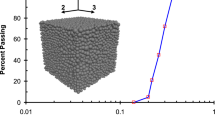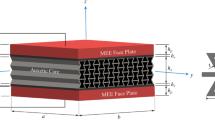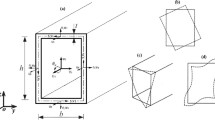Abstract
In this article, the vibration and dynamic instability of cylindrical microshells made of functionally graded materials (FGMs) and containing flowing fluid are studied. In order to take the size effects into account, the modified couple stress elasticity theory is used in conjunction with the classical first-order shear deformation shell theory. The material properties of FGM microshells are considered to be graded in the thickness direction on the basis of the power-law function. By using Hamilton’s principle, the non-classical governing differential equations of motion and related boundary conditions are derived. Subsequently, a Navier-type exact solution method is carried out to obtain the imaginary and real parts of natural frequencies of different modes for various values of fluid velocity, length scale parameter, material property gradient index, compressive axial load, and length-to-radius ratio. It is found that for microshells with lower length-to-radius ratios, the system diverges at lower values of fluid velocity. Also, it is demonstrated that by increasing the value of material property gradient index of FGM microshell, the natural frequency of the first mode and the critical flow velocity of the system increase.








Similar content being viewed by others
References
Aifantis E (1999) Strain gradient interpretation of size effects. Int J Fract 95:299–314
Amabili M, Garziera R (2002) Vibrations of circular cylindrical shells with nonuniform constraints, elastic bed and added mass. Part II: shells containing or immersed in axial flow. J Fluids Struct 16:31–51
Amabili M, Pellicano F, Paı̈doussis MP (2002) Non-linear dynamics and stability of circular cylindrical shells conveying flowing fluid. Comput Struct 80:899–906
Ansari R, Norouzzadeh A, Gholami R, Shojaei MF, Hosseinzadeh M (2014) Size-dependent nonlinear vibration and instability of embedded fluid-conveying SWBNNTs in thermal environment. Phys E 61:148–157
Dai H, Wang L, Ni Q (2015) Dynamics and pull-in instability of electrostatically actuated microbeams conveying fluid. Microfluid Nanofluid 18:49–55
El Chebair A, Misra A, Païdoussis M (1990) Theoretical study of the effect of unsteady viscous forces on inner- and annular-flow-induced instabilities of cylindrical shells. J Sound Vib 138:457–478
Eringen AC (1983) On differential equations of nonlocal elasticity and solutions of screw dislocation and surface waves. J Appl Phys 54:4703–4710
Eringen AC, Suhubi E (1964) Nonlinear theory of simple micro-elastic solids—I. Int J Eng Sci 2:189–203
Ferreira A, Batra R, Roque C, Qian L, Martins P (2005) Static analysis of functionally graded plates using third-order shear deformation theory and a meshless method. Compos Struct 69:449–457
Fleck N, Muller G, Ashby M, Hutchinson J (1994) Strain gradient plasticity: theory and experiment. Acta Metall Mater 42:475–487
Ganapathi M (2007) Dynamic stability characteristics of functionally graded materials shallow spherical shells. Compos Struct 79:338–343
Gao XL, Zhang G (2014) A microstructure-and surface energy-dependent third-order shear deformation beam model. Zeitschrift für angewandte Mathematik und Physik, pp 1–24
Gurtin M, Weissmüller J, Larche F (1998) A general theory of curved deformable interfaces in solids at equilibrium. Philos Mag A 78:1093–1109
Huang Y, Yang L-E, Luo Q-Z (2013) Free vibration of axially functionally graded Timoshenko beams with non-uniform cross-section. Compos B Eng 45:1493–1498
Ke L-L, Wang Y-S, Yang J, Kitipornchai S (2012) Nonlinear free vibration of size-dependent functionally graded microbeams. Int J Eng Sci 50:256–267
Kitipornchai S, Ke L, Yang J, Xiang Y (2009) Nonlinear vibration of edge cracked functionally graded Timoshenko beams. J Sound Vib 324:962–982
Koiter W (1964) Couple stresses in the theory of elasticity, I and II. In: Nederl. Akad. Wetensch. Proc. Ser. B, pp 17–29
Lam D, Yang F, Chong A, Wang J, Tong P (2003) Experiments and theory in strain gradient elasticity. J Mech Phys Solids 51:1477–1508
Langthjem M, Olhoff N (2003) Modal expansion of the perturbation velocity potential for a cantilevered fluid-conveying cylindrical shell. J Fluids Struct 17:147–161
Lee H-L, Chang W-J (2009) Vibration analysis of fluid-conveying double-walled carbon nanotubes based on nonlocal elastic theory. J Phys: Condens Matter 21:115302
Liu J, Mei Y, Xia R, Zhu W (2012) Large displacement of a static bending nanowire with surface effects. Phys E 44:2050–2055
Mindlin RD (1964) Micro-structure in linear elasticity. Arch Ration Mech Anal 16:51–78
Mindlin RD (1965) Second gradient of strain and surface-tension in linear elasticity. Int J Solids Struct 1:417–438
Mindlin R, Eshel N (1968) On first strain-gradient theories in linear elasticity. Int J Solids Struct 4:109–124
Mindlin R, Tiersten H (1962) Effects of couple-stresses in linear elasticity. Arch Ration Mech Anal 11:415–448
Paidoussis MP, Issid N (1974) Dynamic stability of pipes conveying fluid. J Sound Vib 33:267–294
Paidoussis M, Issid NT (1976) Experiments on parametric resonance of pipes containing pulsatile flow. J Appl Mech 43:198–202
Sahmani S, Ansari R, Gholami R, Darvizeh A (2013) Dynamic stability analysis of functionally graded higher-order shear deformable microshells based on the modified couple stress elasticity theory. Compos B Eng 51:44–53
Shaat M, Mahmoud F, Gao X-L, Faheem AF (2014) Size-dependent bending analysis of Kirchhoff nano-plates based on a modified couple-stress theory including surface effects. Int J Mech Sci 79:31–37
Shahba A, Rajasekaran S (2012) Free vibration and stability of tapered Euler–Bernoulli beams made of axially functionally graded materials. Appl Math Model 36:3094–3111
Sheng G, Wang X (2010) Dynamic characteristics of fluid-conveying functionally graded cylindrical shells under mechanical and thermal loads. Compos Struct 93:162–170
Suhubl E, Eringen AC (1964) Nonlinear theory of micro-elastic solids—II. Int J Eng Sci 2:389–404
Timoshenko S, Gere JM (1961) Theory of elastic stability, vol 294. McGraw-Hill, New York
Toorani M, Lakis A (2001) Shear deformation in dynamic analysis of anisotropic laminated open cylindrical shells filled with or subjected to a flowing fluid. Comput Methods Appl Mech Eng 190:4929–4966
Toupin RA (1964) Theories of elasticity with couple-stress. Arch Ration Mech Anal 17:85–112
Tsiatas GC (2009) A new Kirchhoff plate model based on a modified couple stress theory. Int J Solids Struct 46:2757–2764
Vardoulakis I, Exadaktylos G, Kourkoulis S (1998) Bending of marble with intrinsic length scales: a gradient theory with surface energy and size effects. Le Journal de Physique IV 8:Pr8-399–Pr8-406
Wang L (2010) Vibration analysis of fluid-conveying nanotubes with consideration of surface effects. Phys E 43:437–439
Wattanasakulpong N, Prusty BG, Kelly DW, Hoffman M (2012) Free vibration analysis of layered functionally graded beams with experimental validation. Mater Des 36:182–190
Weaver D, Unny T (1973) On the dynamic stability of fluid-conveying pipes. J Appl Mech 40:48–52
Wu T-L, Shukla K, Huang JH (2007) Post-buckling analysis of functionally graded rectangular plates. Compos Struct 81:1–10
Xia W, Wang L (2010) Microfluid-induced vibration and stability of structures modeled as microscale pipes conveying fluid based on non-classical Timoshenko beam theory. Microfluid Nanofluid 9:955–962
Xia W, Wang L, Yin L (2010) Nonlinear non-classical microscale beams: static bending, postbuckling and free vibration. Int J Eng Sci 48:2044–2053
Yang F, Chong A, Lam D, Tong P (2002) Couple stress based strain gradient theory for elasticity. Int J Solids Struct 39:2731–2743
Zhou X, Wang L (2012) Vibration and stability of micro-scale cylindrical shells conveying fluid based on modified couple stress theory. Micro Nano Lett 7:679–684
Author information
Authors and Affiliations
Corresponding authors
Appendix 1
Appendix 1
The classical components:
The non-classical components:
where \(K_{ij} = K_{ij}^{{\prime }} + K_{ij}^{{\prime \prime }}\).
Rights and permissions
About this article
Cite this article
Ansari, R., Gholami, R., Norouzzadeh, A. et al. Size-dependent vibration and instability of fluid-conveying functionally graded microshells based on the modified couple stress theory. Microfluid Nanofluid 19, 509–522 (2015). https://doi.org/10.1007/s10404-015-1577-1
Received:
Accepted:
Published:
Issue Date:
DOI: https://doi.org/10.1007/s10404-015-1577-1




